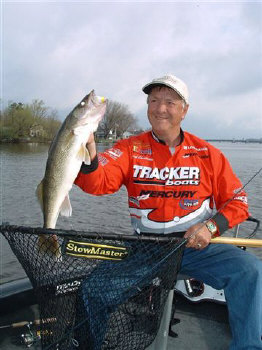Get Out the Jig Rod Now!
Category: article
Mar 31st, 2009 by OutdoorsFIRST
Modified Mar 31st, 2009 at 12:00 AM
Finally, after a winter that wouldn’t end, the ice is melting fast and walleyes and saugers are swarming up rain-swollen rivers all across the United States. It’s jig-fishing time for sure and I want to share some of my favorite tips for dealing with high water and cold water temperatures when chasing river walleyes in March and April.
 |
|
|
Daryl Jigs Up A Walleye
|
First of all, I always use as heavy a jig as I can get away with especially if I’m vertical jigging. I know this often flies in the face of conventional wisdom, but that has been my philosophy for years and I can tell you that walleyes don’t weight a jig before they bite on it.
A heavier jig will allow you to stay vertical much better than a light jig and it will also give you much better “feel” than a light jig. You can detect bottom better as well. Since walleyes are pinned to the bottom in rivers, you want to have perfect control over a vertical presentation and that means keeping that jig on or within a few inches of the bottom.
Sometimes I “dress” the jig with a one-inch piece of twister tail or powerbait to give it a “soft bite” when the fish sucks it in. Other times, I like to thread the minnow on the jig, inserting the hook in its mouth, then threading it on sideways with the hook protruding out of its side.
Walleyes are scavengers often sucking up dead or dying baitfish from the bottom. A minnow hooked in this fashion looks like the right thing. Also, it is almost impossible to throw it off when casting and gets the hook closer to the tail of the minnow. I always use a stand-up jig like an Odd’Ball for this presentation.
I’m also using only braided line when vertical jigging since in gives me a better feel and solid hooksets. It also helps me to get out of snags and prevents being cut off by zebra mussels. I prefer a 6 foot medium action rod as well.
Walleyes will stage below dams as well as along current breaks and clam beds this time of the year. I will drift these areas using my bow-mount to go a little slower than the current. I know I get more bites than traveling at current speed as it gives the fish a little more time to grab the bait. It also allows me to maneuver the boat along a break instead of simply drifting wherever the current or wind takes me.
Another good tip is to make sure you are fishing the fish you are marking on a tight break. Quite often, I see guys jigging with two rods sticking way out from the boat on both sides, yet keeping the boat right on the break. Often their lures are not where the fish are, and while they may catch a few, they are missing the Mother Lode.
Lifting the jig too high is another big mistake as you simply aren’t covering enough water with the jig often off the bottom at least half or more of the drift. Use very short strokes and hops of no more than four inches, especially in cold water. Ticking the jig on the bottom will also help to draw fish over to the sound as they hear the jig approaching.
Sometimes fish bite really light in the cold water and stinger hook helps to catch them. I don’t like using stingers since they tend to snag easy and catch lots of debris, but on occasion, I’ve had to use them and they did make a difference. I’ll leave that decision up to you. I do know that most of the time, if you know where the jig is and work it right, most walleyes can suck it in.
Sometimes plastics or hair jigs can be as effective as live bait when cold water jigging. Last year on the Missouri River, for example, I was consistently catching more walleyes on a three-inch chartreuse tail than on a minnow, but I was casting and retrieving instead of fishing vertical. In all my years of fishing vertically, I can only recall one time when plastics caught more than minnows. Casting and retrieving, however, is a different story and that will be the focus on the next article.
Note: In 2009, I am setting aside some days for personal on-the-water fishing instructions for walleyes, bass, muskies and more. The cost is $500 for the day for one or two people. If you are interested contact me at gr8fish@palacenet.net .